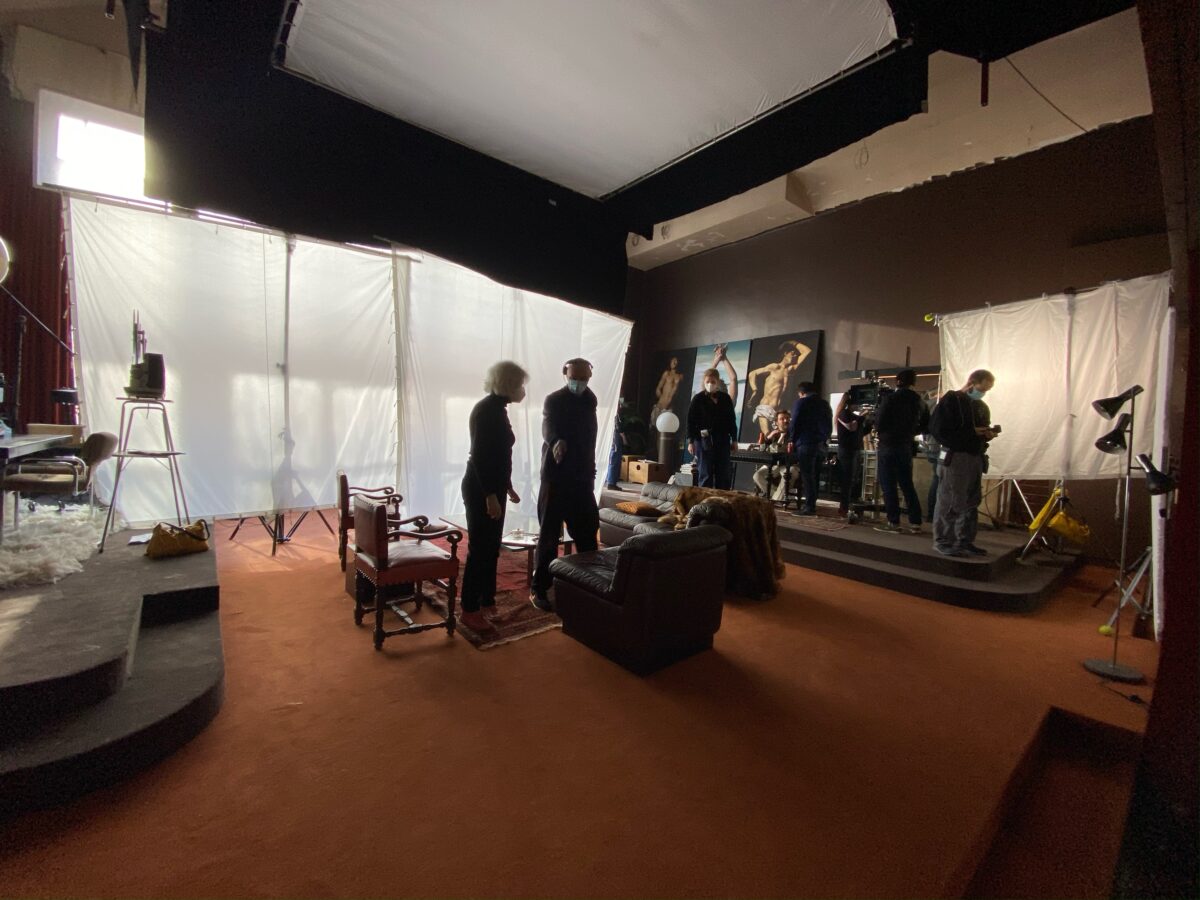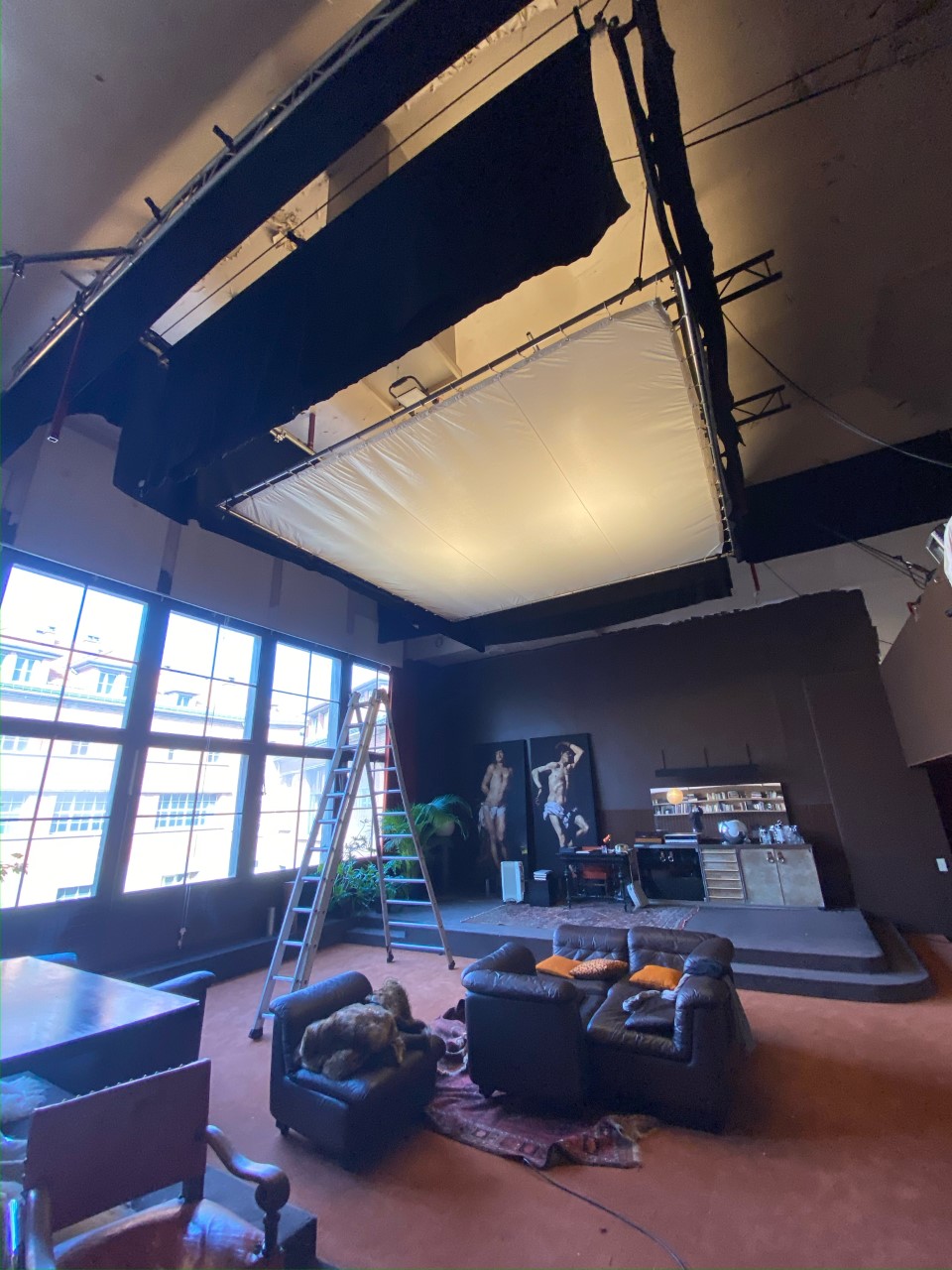TENDER MERCIES Manuel Dacosse on Peter Von Kant

By Oliver Webb.
Adapted from Rainer Werner Fassbinder’s stylised, theatre-esquefilm The Bitter Tears Of Petra Von Kant (1972, DP Michael Ballhaus ASC), Peter Von Kant marks director François Ozon’s second adaptation from the renowned German filmmaker’s canon, after his stage-to-screen rendering of Fassbinder’s play Tropfen Auf Heiße Steine into Water Drops On Burning Rocks (2000, DP Jeanne Lapoirie AFC).
In contrast to Fassbinder’s original Sapphic, psychosexual melodrama, Peter Von Kant switches the genders of the protagonists. Petra, now Peter (portrayed by Denis Menochet) serves as the brawny central protagonist of Ozon’s story, with elements of Peter’s demeanour supposedly based on Fassbinder himself.
Peter is a famous film director, living with his slavish amanuensis Karl (Stefan Crepon). After meeting a young actor, Amir (Khalil Ben Gharbia), through his friend Sidonie (Isabelle Adjani), Peter falls in love and offers Amir a place to stay and an avenue for breaking into the film industry. Much like the original, the story is a chamber-piece, with its multiple acts confined entirely to Peter’s apartment. Hanna Schygulla (who played the Karin in the original) stars as Peter’s mother.
Exploring themes about ageing, mortality, sex, loneliness and sadism, and brought to life in colourful hues by Belgian DP Manuel Dacosse SBC, Peter Von Kant was nominated for the Golden Bear at the 2022 Berlin International Film Festival, where its homage of one filmmaking maestro to another was widely praised.

“Five or six years ago, François called me about a film that would turn out to be the first movie I ever shot in France, and our collaboration started that way,” explains Dacosse. “I shot two movies with him, L’Amant Double (Double Lover) (2017) and Grâce A Dieu (By The Grace Of God) (2019). After the second film I decided to take a break, as François shoots very fast. He’s prolific, and every year he is shooting something. He shot two other movies with Hichame Alaouié SBC Summer Of ‘85 (2020) and Everything Went Fine (2021), and called me back for Peter Von Kant.
“François wanted to take a fairly different approach to this film, in that the gender of the protagonist was switched, and wanted me to shoot this film for him, because I understand and know his work process.
“He also wanted it to be very colourful, and certainly more colourful than Fassbinder’s original film. I think that’s why he chose me for this project when you consider our previous work together. Working with François is quite simple because he has always has a really strong idea of what he wants – the concept and vision of the production design – and then you just have to follow him.
“During pre-production, he showed me a lot of movies made by the master German filmmaker Douglas Sirk (1897-1987), who was, of course, a big influence on Fassbinder. That was the initial approach to Peter Von Kant,” says Dacosse. “Obviously, François is a big fan of Fassbinder’s work, but I didn’t know his work so well, so he also pushed me to look at more of those films.
“I watched the original The Bitter Tears Of Petra Von Kant during prep, shot by the renowned DP Michael Ballhaus ASC. When you look at the movie, it’s a really character-driven piece set, filmed almost entirely in a small set, and there is even a shadow of the camera. We had a huge set compared to the original. We also had a glossy wall to contend with in terms of the light and handling reflections.”
Dacosse selected ARRI Alexa Mini, shooting at 160 ISO, fitted with zoom optics for the production. “François loves to work with zooms, so I went with the Cooke Varotal 18-100mm T3 and Panavision SLZ11 24-275 mm T2.8 lenses. I shot on the Alexa Mini because I really trust it and know I can push it to the limit. There was a discussion about shooting on the Sony Venice, but I don’t know the camera so well yet.
The film, a single camera shoot with Ozon operating himself, was made over a period of four weeks, and was shot on a set that was constructed inside an old school the suburbs of Paris.
“It was really a small budget for François, around €2 million,” remarks Dacosse. “There were only two exteriors to shoot, one street behind the building and then the exterior of the building. The main room itself was very big, and it was cool to work in there. The only problem was that it had a huge window and sometimes the sun reflected in from another building opposite, so I had to fight quite a bit to balance that and protect the light.”
An additional, and interesting, proposition for Dacosse, was that Ozon likes to operate the camera himself. “François loves being at the centre of the set and being close to the actors. He also gives pace to the shoot. So my work was very much focussed on making it easy for him to move the camera around the actors, and frame the action with the appropriate freedom and lighting.
“I was never far away, observing with a monitor, and course we had the first AD on the-set, but you always listen to François. Some directors work with a monitor, but François is the only one I know who operates the camera.
“However, the main problem when François is framing is that he is often ready-to-go, but you are not always ready with the lights, so you have to work quickly. But I love working quickly and enjoy a good pace on-set. I think he enjoys working with me because we don’t talk so much and I just follow him. I don’t ask too many questions. That works well for both of us.”
One shot proved to be particularly challenging to complete, as Dacosse notes, “There was a long take, when we start in the bedroom and finish in the living room, and we have to pass through a corridor. The bedroom was full of sun and in contrast, the corridor was really dark and the living-room was in shadow. This meant we had to played with the T-stop on the camera and had to put some 18k outside of the living room, as there were occasionally clouds and so we had to adjust strength of the 18K during the take.”


As for injecting colour into the film, Dacosse says that, “For the night scenes, for example, François wanted a very blue full-moon atmosphere, so I really pushed the blue which added a feeling of warmth. The whole movie in that sense is very colourful, except for the daytime scenes, which were more problematic. I tried to bring some colour to those scenes in a variety of ways, such as in the design of the wall and other things like that in the set dressings and design.”
Dacosse says he paid great attention to lighting the actors, such as Isabelle Adjani, who despite being 60, looks as if she could be in her 30’s in the film. “I balanced strong front light on them with strong colour behind to always keep a good contrast, with full red and full blue on the walls, an ARRI SkyPanel behind the actors, whilst being careful with the gloss of the wall.
“The while lighting set-up was controlled from an iPad, so when the camera was moving I could dim some lights, or push up others lights to maintain the contrast. This proved challenging sometimes, but new lighting control technology it is very helpful because you can change the illumination during a shot and you don’t really feel it changing. All of the lighting gear we used came from TSF France.”

Recalling his experience and learning experience of shooting Peter Von Kant, Dacosse concludes, “Don’t be afraid of the dark. Always follow the director. Trust them when they push you to take risks and follow your instincts.”
interview kindly provided by Ronny Prince and Cinematography World.
